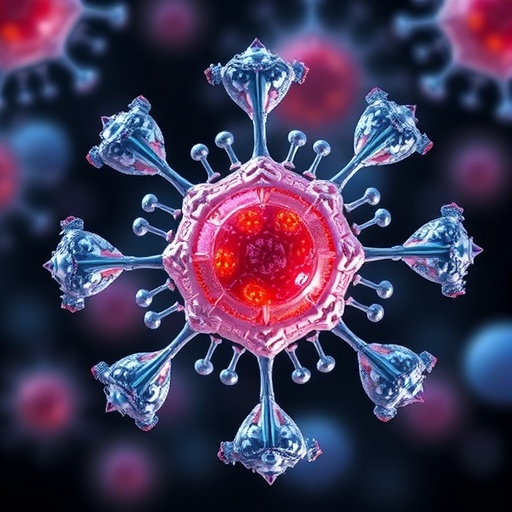In a groundbreaking development poised to revolutionize the field of nanomedicine, an Australian research consortium has engineered a novel class of lipid nanoparticles (LNPs) exhibiting intricate internal configurations that challenge conventional paradigms of drug delivery systems. This breakthrough, achieved through the advanced capabilities of the Australian Synchrotron combined with cutting-edge cryo-imaging techniques, heralds a new era of precision therapeutics, diagnostics, and gene editing applications with far-reaching implications for patient outcomes worldwide.
Lipid nanoparticles have become synonymous with modern drug delivery, notably serving as the crucial delivery vehicles for mRNA in the Pfizer–BioNTech and Moderna COVID-19 vaccines. These nanoparticles encapsulate fragile nucleic acid molecules, enabling them to survive systemic circulation and successfully transfect target cells. Building upon this well-established foundation, the Australian team has transcended previous design limitations by synthesizing LNPs that self-assemble into “nonlamellar” mesophases, such as cubic and hexagonal crystalline structures. These architectures offer significantly increased surface area and cargo accommodation versatility, broadening the spectrum of deliverable therapeutics beyond nucleic acids to encompass proteins, metal ions, and small-molecule drugs.
The intricate internal geometry of these LNPs embodies a profound leap in nanostructure engineering. Traditional “lamellar” lipid phases arrange themselves in planar bilayers, which, while effective, impose spatial constraints on encapsulated materials. By contrast, the newly characterized cubic and hexagonal mesophases present three-dimensional periodic minimal surfaces, dramatically amplifying the interface between the lipid matrix and encapsulated cargo. This enables more robust protection, greater loading efficiency, and controlled release profiles, essential qualities for next-generation therapeutic platforms.
Central to this innovation is the incorporation of polyphenols — a class of naturally occurring plant-derived compounds celebrated for their antioxidant and anti-inflammatory properties. The researchers harnessed the molecular interactions between polyphenols and lipids to drive the assembly of these unprecedented crystalline phases. This synergistic combination not only stabilizes the nanoparticle architecture but also introduces bioactive properties that could augment therapeutic efficacy and biocompatibility. Such a design approach exemplifies biomimetic principles, marrying nature’s molecular toolbox with synthetic engineering to optimize functional outcomes.
The study’s co-lead investigators, including Laureate Professor Frank Caruso of the University of Melbourne and Dr. Yi (David) Ju of the Olivia Newton-John Cancer Research Institute and La Trobe University, emphasize the tunability of these nanoparticles. By modulating formulation parameters—such as the ratios of polyphenols to lipids, solvent conditions, and temperature—the internal mesophase structure and particle size can be precisely controlled. This tunability is critical for customizing delivery vehicles suited to distinct classes of therapeutics, ranging from hydrophobic small molecules to large nucleic acid constructs.
Such versatility opens expansive possibilities in pharmaceutical sciences, especially in the rapidly evolving sectors of mRNA therapeutics, cancer immunotherapy, and genetic medicine. Given the global surge in RNA-based vaccine and therapeutic development catalyzed by the COVID-19 pandemic, the ability to engineer nanoparticles with enhanced cargo capacity and delivery efficiency is of enormous translational significance. Notably, these LNPs can be produced using existing vaccine assembly infrastructure, streamlining the path from bench to bedside while potentially reducing production costs.
Beyond therapeutics, these architecturally sophisticated LNPs possess promising applications as diagnostic nanomaterials. Their increased surface area and structural intricacies offer new modalities for targeted imaging agents, biosensors, and theranostic platforms where diagnosis and treatment converge. This dual functionality could reshape clinical approaches to disease monitoring and personalized medicine.
The research team has secured international intellectual property covering the compositions, methods, and applications of this new LNP class, reflecting their commitment to translating fundamental discoveries into real-world solutions. Industry partnerships are actively sought to accelerate the development pipeline, with in vivo validation anticipated within five years. The commercialization potential of this platform is substantial, promising both enhanced therapeutic indices and broader patient access due to economic manufacturing benefits.
Technically, the deployment of the Australian Synchrotron was pivotal for elucidating the complex internal lipid arrangements. High-resolution synchrotron X-ray scattering provided unparalleled insights into the mesophase topology, distinguishing cubic from hexagonal phases with remarkable clarity. Complementary cryo-electron microscopy enabled direct visualization of particle morphology in near-native states, validating the structural models and informing iterative design optimization. This hybrid methodological approach epitomizes modern materials science’s integration with biomedical innovation.
Collectively, the findings delineate a new frontier in nanomedicine, wherein molecular design, natural product chemistry, and advanced characterization coalesce. The implications extend beyond liposomal drug delivery to inform broader material science disciplines, including catalysis, membrane science, and soft matter physics. As translational efforts progress, the medical community stands to benefit from safer, more effective nanoformulations tailored to the complexity of human diseases.
In conclusion, this Australian-led advancement in polyphenol-mediated lipid nanoparticle engineering manifests an inspiring example of interdisciplinary collaboration achieving technological breakthroughs. By harnessing the nuanced interplay of chemistry and physics at the nanoscale, these novel LNPs promise to enhance the therapeutic landscape profoundly. The next decade could witness their integration into clinical paradigms spanning oncology, infectious diseases, and genetic disorders, underscoring the transformative power of nanotechnology in medicine.
Subject of Research: Not applicable
Article Title: Polyphenol-Mediated Engineering of Lipid Nanoparticles With Crystalline Mesophases
News Publication Date: 15-Sep-2025
Web References:
https://advanced.onlinelibrary.wiley.com/doi/10.1002/adma.202505830
References:
DOI: 10.1002/adma.202505830
Image Credits: Dr Shiyao Li
Keywords: Biomedical engineering, Nanomedicine, Drug delivery, Drug delivery systems, Targeted drug delivery, Nanomaterials




